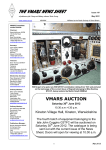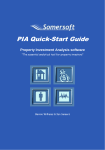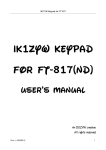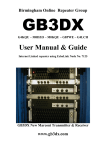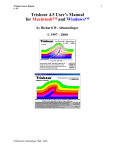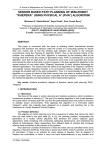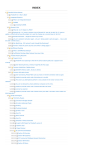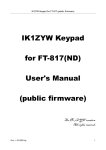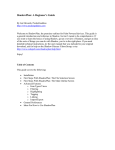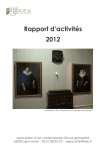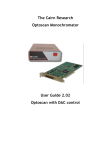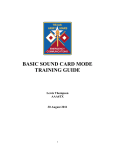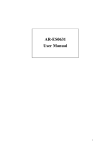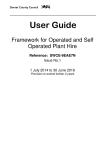Download the March 2009 in Adobe PDF Format
Transcript
DOVER RADIO CLUB Affiliated to the Radio Society of Great Britain G3YMD T h e Ne t March 2009 Enigma-e machine constructed by Fred G4GAN (SK) See a tribute to Fred on page 9 Copyright Dover Radio Club 2009 Information Pages Club Meetings The Club meets at the Dover Grammar School for Boys at 7.30 for 7:45pm every Wednesday during term time. The first and third Wednesdays of each month are normally operating/natter evenings. Operating takes place in a separate room to the natter sessions. Members and guests seeking operating experience or hobby related advice are encouraged to use these evenings for their development. The second, fourth and the occasional fifth Wednesday evening of each month are reserved mainly for radio related talks, demo’s and event planning. Contacts Chairman: Matt Curtis M1CMN Secretary: Brian Cuff G4SAU Membership Secretary and Treasurer: Nigel Evans M0NDE The Dover Club is registered as an examination centre. All forms of training can be arranged. Please contact the appropriate person from the list below via the links on the club website. Foundation Licence Training Course: David Harding G0DQI Intermediate Licence Training Course: Brian Joyner G8ZYZ Advanced Licence Training Course: Tony Phillpott G4IMP Morse Coaching: Ian Keyser G3ROO & David Harding G0DQI Examination Secretary: Brian Joyner G8ZYZ Contribution and news items for inclusion in The Net should be sent to the NET Editor: Brian Joyner G8ZYZ Website: www.darc.org.uk 14 2 Local Net The Dover Radio Club “White Cliffs Net” is on air at 10.00 Hrs local time on 3.745MHz (+/-) then QSY to 1. 888.00 Monday to Sunday. Please feel free to join in. Dstar Net There is a local DSTAR Net for locals on GB7FK / GB7DX / GB7IC on Tuesday evenings from 8pm. Please contact Matt M1CMN or Declan M0TMX for more information. Local Repeaters VHF voice repeaters covering the catchment area of the Dover club are GB3KS at Dover (145.625MHz) and GB3FK at Folkestone (145.750MHz). There is no UHF repeater in the immediate locality but GB3EK at Cliftonville Tx (Output) 430.8875 MHz, RX (Input) 438.4875 MHz [Offset 7.6 MHz] CTCSS 103.5 Hz (look at www.gb3ek.co.uk for more information) and GB3SK at Canterbury (433.150MHz) provide good coverage with the exception of the low lying areas of Shepway. GB3FK is operated by the Folkestone Repeater Group, further information can be obtained by logging onto www.gb3fk.com The remaining repeaters mentioned above are run by the Kent Repeater Group and full details of all their repeaters can be found on their web site at www.krg.org.uk Voice Repeater Access and Usage All the voice repeaters in Kent can be accessed by a 1750 Hz tone of between 200 m/seconds and 1 second OR by CTCSS tones of 103.5 Hz (except GB3SK) followed by at least 3 seconds of audio this can be achieved by giving your own call sign twice to ensure the repeater is opened properly. ALWAYS wait for the over signal, usually a ‘K’ or a ‘G’ between overs before transmitting. The ‘G’ indicates access by CTCSS. 14 3 D-STAR Digital Repeater GB7FK - This digital repeater is located in Capel, between Dover and Folkestone. Port B 439.7375 MHz Port C 145.7875 MHz Please send your reports to: Matt M1CMN. This is very new technology, and we are all still learning about it. To join the fun, and find out more information please join the Kent DSTAR Yahoogroup. Also visit the GB3FK Website for more information. www.gb3fk.com APRS Internet Gateway MB7USK – Folkestone Based APRS Internet gateway using UIVIEW operating on 144.800MHz under the call sign of MB7USK. To find out more about UIVIEW visit http://welcome.to/mb7usk Television Repeater An Amateur Television repeater is located on the Isle of Sheppey with an output frequency of 1,310MHz. It is run by the Kent Television Group (KTG) who provide further details on their website www.kentelivision.org New to the hobby or the club ? There are many parts of the hobby to explore, and we have many members with experience in different areas. Please contact Brian G8ZYZ for the list to be modified / updated. Mode Name / Callsign to contact CW / Morse Ian G3ROO, David G0DQI, HF Antenna design Ian G3ROO 6 Metre Operation Tony G4IMP Amateur Television Brian G8ZYZ, David G0DQI Repeaters and VHF/UHF Matt M1CMN, Declan M0TMX D-STAR Matt M1CMN, Declan M0TMX, Ben M0TUX Weather Satellite reception Nigel M0NDE 14 4 C Chhaaiirrm maann’’ss M Meessssaaggee Well, another year has flown past, and here is the report I presented to the AGM last week. Introduction First of all I would like us to remember Fred who sadly passed away this year, I am sure he will be remembered by all members of the club for his enthusiasm, help, and kindness. As ever we owe a great deal of thanks to many members of the club for the work they do. It’s often hard to list people in case I miss someone out! We have the team of trainers for all courses, the examination team, people that organise the special events, those that contribute to the club newsletter, and those that support and take part in the many talks and activity’s the club runs. A lot goes on behind the scenes at the club, with many hours spent organising, arranging and planning. It’s very hard to think of new things to do, and keep everyone in the membership keen. We have a hobby that has many activities associated with it and we are very lucky to have experts in many fields. Special Events During 2008 we ran 2 special event stations at the South Foreland Lighthouse, one for Marconi day, and one for international Lighthouse weekend. This coming year will be very exciting with the lighthouse events planned, and the big event on the seafront / at the castle this summer. Plenty of opportunity to get the event running well. Talks and Demos The club has seen a variety of talks, demonstrations and social evenings during the year, we have had several talks from guest speakers to the club, all of which have been very well attended by members. A big thank you to Anne G4RJZ / Marion who continues to serve the refreshments at every meeting, and outside special events and to Marion who has done an excellent job with the raffle, with a great selection of prizes each week The club needs to continue to move forward in the future – first I think to try and find some young blood, we are all getting too old !!!! But I would like to finish by saying to everyone – please get involved with the club. The club needs ideas, and support to continue in the future and to grow. 73 Matt M1CMN 14 5 Your Officers and Committee for 2009 At the Annual General meeting of the Dover Radio Club held on Wednesday 18th March 2009 the following persons were elected to hold office for the forthcoming year:Officers: Chairman: Secretary: Treasurer & Membership Secretary Matt Curtis Brian Cuff Nigel Evans Committee Members: Ann Philpott, David Donahoe, Declan McGlone, Ian Keyser, Peter Love and Brian Joyner Non-executive posts: Web Master Matt Curtis ‘Net’ Editor Brian Joyner Auditors: Tony Phillpott and Marion Joyner. The birth of Dover radio club Ian Keyser, G3ROO While driving down to the club one wet evening last November I suddenly realised that I had done this before on another wet November night, but 40 years earlier! It was on a wet Wednesday night back in November 1968 that we held our first meeting of the Dover (YMCA) radio club in the YMCA building in Layburn Road Dover. A group of us had been meeting at a pub in East Langdon during the course of the summer. They were Jack Court, G3KKF (KIPPER KIPPER FLOUNDER) Steve Whiteman, G3YQR, Scott West (someone please remind me of Scott’s call!) John Maddison, G3KAW (thanks for reminding me Brian!) and Myself. John who was the manager of the YMCA in Dover had suggested that we form the club at the YMCA under the banner of the YMCA, that way we could use the hall and facilities free of charge! At the meeting John was elected Chairman, Steve was treasurer and I was secretary. I had in my bag a red, hard backed British rail account book that was pressed into service as the minute book. As we wanted to build some funds there was to be a 10/- (ten shillings, or in modern money 50p) annual membership and six pence a night. That was a lot of money in those days and it was then decided to split it into two 5/- payments on the 1st Dec and 1st June. For that reason I think the date must have been either the 21st or the 28th on November. ( I've just checked the days for Nov.1968) We were soon joined by a SWL, Bert Albright, who was the manager of a Dover jewelers, and then by Bill G2B?? who lived at 200 Elms Vale Road. 14 6 We soon had a station up and running when Ray Butler G3ZAC joined us and loaned us his Canadian 52 set receiver. I have one now and it was one of the best receivers at that time, and still is a joy to use although looks rather 'funny'! The Tx was a three valve AM CW TX for 1670 and 80m that I built. We had three club nets, at 1030 AM on 80m AM on Tuesdays and Thursdays and then on Sunday morning on 160m. These had the dual advantage keeping us in touch with what each of us was building or modifying and increasing the membership. It must be remembered that at that time there were only a few commercial wireless's available to us, In the UK we had KW and T (Tom) Withers. And from the US Collins and the equipment cost was way above what most could afford. Post war austerity was still very much at the fore, we were more interested in keeping warm than anything else! For us plebes, we either went to jumble sales, bought old radios and stripped them for components to built a station or we saved up for a surplus radio and modified it to provide a station. Talk about making silk purses out of sows ears, some were real works of art. All I could afford was a 19 set 65/6p (£3 5s 6d) but his could be coaxed to give five watts out on CW on 80 and could be made to cover the top end of 160. For this reason the club net was moved to 1990KHz, as far HF in the band as we dared to go without attracting the wrath of the Post Master Generals inspectors. Frequency measurement then was more than a little hit and miss, to get within 3 Khz of any frequency and you were doing well! Unlike now there were three inspectors in any area, Canterbury area at that time I believe included Folkestone to Faversham and all points east, and we all got regular visits to check our logs and station output. One day I was talking to Mike Dennison (later editor of Rad Comm) on 160 who at that time lived in digs in Canterbury. He had aerial problems and I related to him, 'on air', that when in London I used to use a disused telephone line that was still attached to the house.... the following morning I had two gents in bowler hats at the door to tick me off and sign my log with a warning! They had been monitoring our QSO. The club shack was in the old air raid shelter at the front of the YMCA and was not damp, but WET. Very soon the gear started to suffer so John Maddison and I decided that we would buy a shed between us for the club. He knew a chap who made sheds and inquired the price of a really good shed. We had expected to pay about £20 but the price was a staggering £50, over a weeks wages for both of us but we persuaded the company to accept £10 per week. When we went to see the shed we agreed that the quality was excellent. We also got the agreement that the company would erect the shed, a big advantage as the place it was to be located was only just big enough to take it. The committee agreed that it would be better if only two bought it as they could be considered guardians and whereas if there were more people arguments would ensue about the best way to utilise the facility. John and I had free reign to fit out the interior. At the first committee meeting it was decided and agreed that if either of us left the club or turned toes up the £25 would be found from club funds to reimburse us. At the next meeting someone suggested that instead of this arrangement we should be offered life membership and this is what John and I accepted as club membership was now £2 per annum and likely to rise. Peter Pennington must have joined the club about this time and due to Peters RAE course the club membership soared.... soon we had a paper membership of 150 with up to 50 members 14 7 present at meetings. At this time Class B licence holders far outnumbered class A and the interest was predominately VHF. I lost interest in the club due a number of factors, a growing family, there were few with a common interest to me but worst of all club members piled into the shack making it impossible to use the gear. John and I protested but they remained so I decided that |I would rather use my valuable time on the air at home. In the early 80's and after a gap of about five years I returned to the club and one day was giving a talk to the membership when I thought I recognized a face I had not seen for some years... I walked down the hall to find that it was Dick Pascoe. Dick had been a good friend and diving buddy of mine but for some reason we had drifted apart People who know Dick will know that as soon as he joins a club he rapidly rises to the top! Within a couple of years he was Chairman and I was Vice chairman! At about this time (1984) the RSGB took over the Morse testing service. I became the senior examiner for Kent and Dover Radio club was to host the tests. Fred, G4GAN and a team had recently moved the shed to the back of the YMCA and did a wonderful job of repairing it and modifying it to fit underneath a car port. I fitted it out for Morse testing and training. The club bumbled along, the face of amateur radio changing rapidly but then disaster struck and we were no longer welcome at the YMCA. I am not sure of the politics but it was not a happy time. At this time I had met Katherine Carson when she asked me to give a talk to her class on Samual Morse. This was a great success and resulted in Katherine joining the club. It turned out that her husband Mike was head of Science at the Duke of Yorks school and we were invited to hold our meetings up there. It was ideal! We had a dedicated shack, a 60ft tower and the use of three classrooms. This continued for some years until the shack was required for other uses. We then moved to our present location at the Dover Grammar School where David Harding was a teacher. We had the use of the tower for a shack and again three classrooms. Unfortunately the tower started leaking and soon became untenable. The gear was then moved to a locker in one of the classrooms with the idea of setting it up in one of the classrooms each week. I erected a doublet and the feeder could be retrieved through an open window to connect the radio. Unfortunately this was not a very satisfactory arrangement and soon the gear remained in its locker Fortunately that is now changing back, the tower is now repaired and usable, the operating bench has been refurbished and in a very short time we will have a dedicated shack again. It is now time for someone else to continue the story of Dover radio club and correct any errors I have made, dates all a bit vague now! 14 8 Fred Knight G4GAN Silent Key Fred passed away suddenly at the talking newspaper studios in Deal on Monday 12th January. He will be remembered by so many for his voluntary work in several fields, in fact the local Deal newspaper stated, “Fred was one of Deal’s most devoted volunteers for local charities”. Fred was a volunteer for the White Cliffs Talking talking newspaper for over 20 years. Working behind the microphone his contribution was probably one of the most important as he installed all of the equipment in the studios, carried out repairs to the players used by the blind listeners and also acted as sound and recording engineer during production. As if that wasn’t enough to keep him occupied Fred actively supported the Deal Maritime and Local History Museum. Over the past year or more he put his considerable woodworking skills to good use in the complete restoration of one of the few remaining man powered whalers of its kind in the UK. As a radio amateur Fred will be remembered for many things. An example of his construction abilities can be seen in the cover picture. He built the Enigma-E machine from a kit but then housed it in a splendid wooden case and then searched everywhere until he obtained a 1940s typewriter from which he removed and adapted the keys to give his machine an authentic WW2 keyboard. I hope to be able to bring you some good news about this in a future edition. Others may remember Fred as a very keen operator. On VHF during the 1980s he worked some very impressive DX from his sea level QTH and was a very active member of the clubs successful contest team. He also loved Special Events, not only operating but also researching archives and producing some excellent displays to enhance our patch at many events. Fitting out the shed at the YMCA in the 1980s Adjusting the H.F. beam during Quexpo 1982 Operating at South Foreland Lighthouse 2007 So many amateurs will remember and thank Fred for his training role. In 1990 it was announced that the Novice grade of licence was to be introduced and Fred was amongst the first to offer his services to instruct and administer the courses at Dover. In those days the City & Guilds was the examining body, in addition to his other duties Fred took on the role of Examination Secretary at Dover until the examining body was changed to the RSGB. 14 9 In appreciation of his outstanding contribution to the club and to amateur radio Fred was made an honorary life member of the Dover Radio Club in 2005. I will personally remember Fred as someone who could be completely replied upon. When he undertook a task you could forget about it, knowing that he would quietly go about it in a professional manner, paying great attention to detail and delivering a top class job on time. Thanks Fred. Brian G8ZYZ Getting the most out of your wireless Pt 1 Choosing a modern radio! Ian Keyser, G3ROO You may think this a silly title for an article, but far, very far from it!. Radio's we buy are designed for different uses and we have to be careful if we use a radio for a purpose for which it is not designed. This applies to both VHF and HF radios on all modes so do not think that because you only use FM anything will do. The main criteria that a designer is wanting to know is what sort of aerial is it to be used on.... Why? Well, big aerials produce big signals and front ends must be able to cope with those signals. Small aerials produce small signals so the set has to have enough sensitivity to resolve these small signals. A set designed for handling small signals cannot be made (without very great expense and lots of current) to handle big signals. When we put that little hand-held onto a 5 element Yagi the poor thing suffers. The first thing that happens is that is loses sensitivity, this is because the signals arriving at the aerial socket get distorted by the RF amplifier and 'cross modulate'. The effect of this is to produce noise which swamps the weak signals. The other is squawks and bangs....and snatches of speech that cannot be explained 14 10 On HF there are two requirements, the set for portable and the set for main aerial use..... not 'base set' that conveys nothing as your set can often be used 'in the field' on massive aerials! Unfortunately companies have tried to make a general purpose set and to a degree they have succeeded. The problem is that very few amateurs really know how to use them to enable them to be used on a big aerial.... and when I mean big I only mean a full size dipole, not a beam. Sensitivity on HF is rarely a problem, even in very basic sets it is possible to hear solar noise ( if you know what to listen for) and in the average environment that is masked be local QRN. So the most important thing is for the set to handle Bill's transmission in the next street without cross modulating. Sets like the IC706, 7000, FT857 and 897 do not stand a chance unless driven properly and Icom and Yaesu have both built in provision for this..... but very few modern amateurs know how to utilise them, the reason is they have failed to read the user manual and UNDERSTAND what they are reading! If you have one of those sets the first thing to do is to turn off the RF amplifier when on HF. On Icom there is a button to do this...For some silly reason Yaesu have made this important requirement a menu item AND made it unclear what you are doing. They invented this wonderful phrase IPO meaning 'Intercept Point Optimisation'..... how many of you understand that.... very few M3's I expect and plus a number of full licence holders. It means 'RF Amplifier OFF' Yes, IPO in the ON position means RF Amp OFF. Oh Mr Yaesu, you have lost the plot completely now! So on HF …..Icom owners have the RF AMP OFF and Yaesu owners IPO ON , and the reverse when using the sets on mobile whips. This is one of the reasons why I would like the club to buy a decent radio, IC756 Pro 111 ideally, it would be the best set for contesting, it would show club members what a good set is like to operate. I dearly hope that it will also encourage club members to set up the station on club nights because they can operate a set they cannot afford at home. Perhaps even inspire them to higher things.... There are numerous other useful facilities on your HF radio which I am sure a lot of you do not fully understand. Over the next few NETS I hope to make some of them clear so you will get the maximum enjoyment from your radio. Work in WORK IN PROGRESS Congratulations to Catherine M1CVF and Matt M1CMN for all the time and effort they have put into creating the new look club website. They have totally updated it and I must say that the new crisp and clear format is a great achievement. Work is still in progress so keep an eye on it frequently over the course of the next few weeks. Brian G8ZYZ 14 11 Training Brian G8ZYZ Foundation Course Eight students attended the course run on 21st and 28th March. I am pleased to report that six of them were successful in the examination with two more failing by the very narrowest of margins. We have now had 161 successful candidates and we have just maintained our success rate of 92%. Some of the Foundation course students and instructors 28th March Photo by Tony G4IMP.Another of Tony’s photos with the names of each student can be found on the homepage of the club website. Intermediate Course The most recent Intermediate course was completed a few weeks ago and I am pleased to say that Bruce Stewart-Whyte, Graham Wells, Iain Vickers, John Roberts, Kris Aird, Leslie Brett, Owen Cooper and Tony Willsher all passed the examination held on 11th March. This result maintains our excellent record of a 100% pass rate at this grade. The result was something of a relief as just two weeks before the course commenced Fred G4GAN (silent key) advised that he was unable to continue as an instructor. Tony G4IMP very kindly offered his services, he was joined by Steve M0SGE so the construction side of Intermediate training was soon back in very capable hands. Advanced Course The next Advanced training course is scheduled to commence during the autumn this year. Judging by the number of people who have already expressed an interest it looks as if it will be very well supported. 14 12 Some thought on operating! Ian Keyser, G3ROO I have just been visiting a friend and we did a lot of listening to 80 and 40m SSB. Generally we were pretty disgusted with the standard of operating that we heard. Not only operating procedures but bad language, one amateur who I intend to report to Ofcom was continually 'Effing and Blinding'! Of course this is a case of one in a thousand but it does highlight one of the problems with the new UK amateur licence structure. A large number of newly licensed amateurs have not had an apprenticeship in the hobby as short wave listeners. This manifests itself in poor operating practice and other related problems. Operating the average FM VHF hand-held creates little problem once repeater shifts and tone bursts are mastered and communication can proceed normally, or near normally. One of the major stumbling blocks is how to order callsigns. It may, at first, seem silly to have an order of callsigns but there is a real reason for having a convention and keeping to it. On VHF FM there is little problem, signals are usually Q5 and so if there is some confusion it is soon cleared up. On VHF SSB and HF it is completely different, signals are weak and often troubled by QRM, QSB and QRN. In these conditions it is far better to know when to expect the callsign you are interested in. Think of it this way, if you give the other stations callsign first he is far more likely to recognise it in the QRM and know which voice to concentrate on. So if I hear deep down in the noise “Gee ~~~~ Radio Oscar ~~~~” I am alerted to the fact I am being called so can then concentrate on the “this is Victor Kilo six ~~~ Hotel ~~~~” and can go back “ QRZ Victor Kilo Six?” and can likely get the contact. Compare that to “This is victor kilo six ~~~~~~~~~ delta calling germany three radio oscar oscar” mentally what happens is 'who was that calling me?' A hopeless situation. This is the problem on sideband, but it is just as bad with CW, perhaps even worse. My foreign friends are very upset by poor operating practices of M3's to the point that they will not call them. They complain that they have enough of a problem having to converse in English without having to try and 'decode' who is calling them! When I mention this problem to the newly licenced I get the very narrow point of view back.... ' I don't go on SSB or HF so why bother', well, my answer to that is that you MIGHT do so in the future and if you do not get it sorted in you mind now you WILL make a fool of yourself in front of our international friends. The whole ethos behind amateur radio is consideration to others and that we are all equals. In the past when I worked Sir Cliff Richard or any other licensed celebrity or royalty it is 'Cliff' or 'Hussein' …..Ah, one exception, Gandhi was always Gandhi!! 14 13 Dates for your diary International Marconi Day Saturday 25th April The club will be operating GB2SFL from the South Foreland lighthouse over the weekend of 25 –26th April. Please listen out for announcements at the club or see further information on the G3YMD group very soon. Dover Radio Club Programme April 2009 1st April Presentation on Radio Signal Mapping by Denis G0SLJ 8th April School holiday - Net on GB3KS 19:30Hrs 15th April School holiday - Nosh and Natter night at the Mayfly, Hawkinge Nr Folkestone 22nd April Contest group discussion lead by Declan M0TMX 29th April Operating night in the new club shack PLEASE NOTE On the odd occasion the committee may be forced to change the programme at short notice due to circumstances beyond their control. Please check for updates on the club website regularly. 14 14














